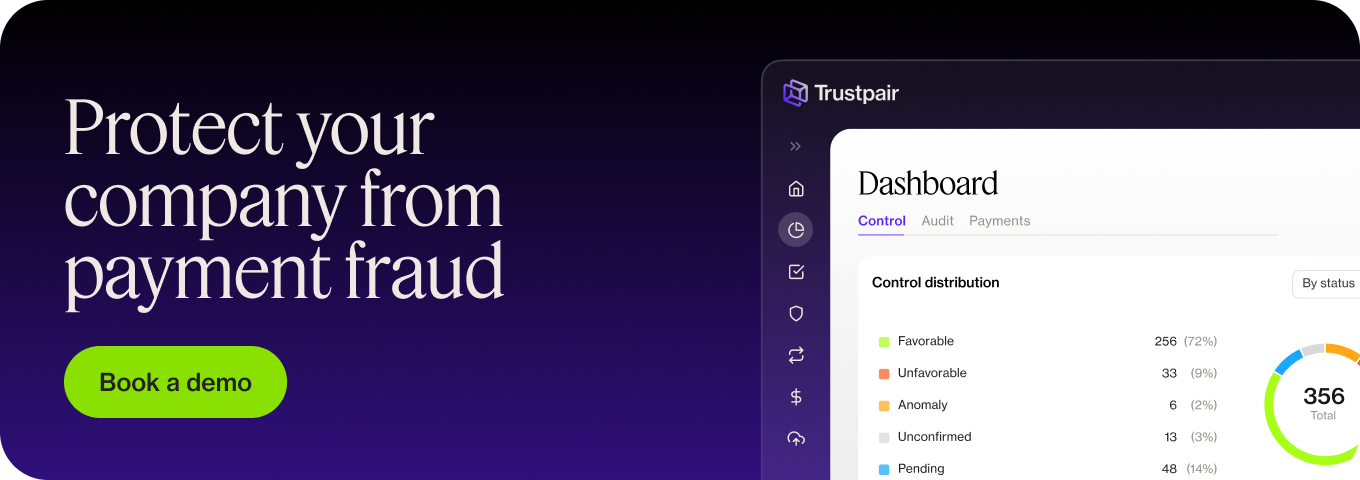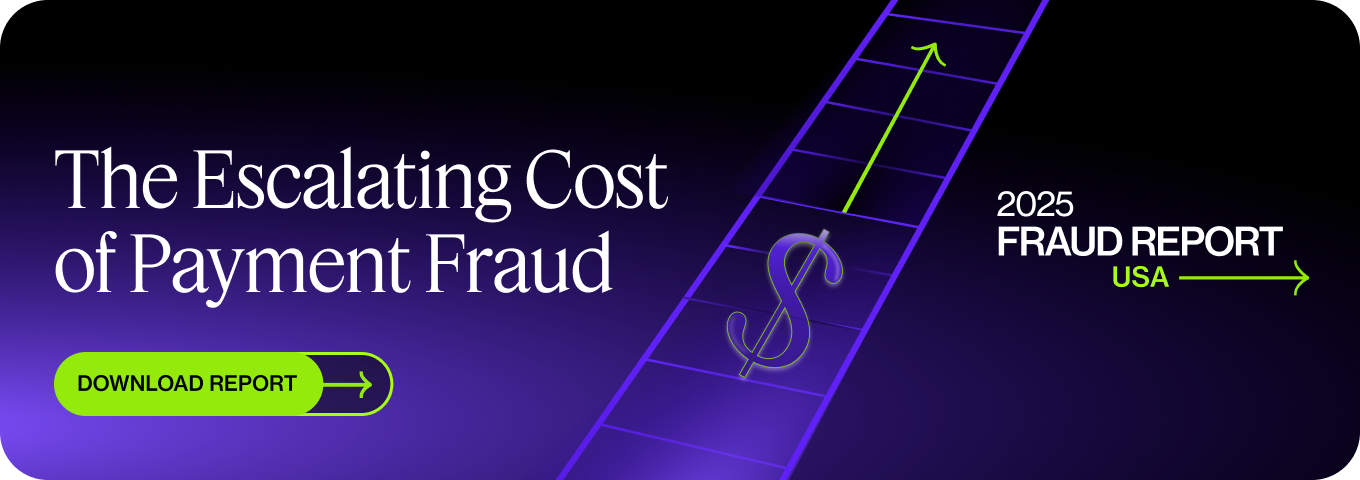In 2023, 96% of US companies were targeted by at least one fraud attempt, with negative consequences that go beyond financial losses. With so many types of fraud to look out for, what fraud protection measures can you set up to protect your organization?
Trustpair is the ultimate protection tool for businesses. It automates all third-party controls and detects any suspicious activity whilst auditing all payments online before they’re executed. Contact an expert to learn more!
What are the different types of fraud?
Over the past few years, fraudsters have unfortunately become more creative with their attempts. Elaborate fraud schemes are twofold:
- Fraudsters gain access to sensitive information,
- They leverage it for financial gain.
Most financial fraudulent attempts are wire transfer scams. Scammers use a variety of methods to convince their victims to wire them money, like identity theft and false pretenses.
Let’s have a look at some common types of defrauding:
CEO fraud
This is when a scammer impersonates the CEO or another member of your top management (in this case this is “whaling”). They pretend to be someone with high authority to get their potential victim to do a transfer without too many questions.
Fraudsters ask an employee to make a transfer to an account number under false motives like paying a new supplier or finalizing a strategic deal. The transaction is often “urgent” and they pressure their victim-to-be to act fast, trying to bypass their critical thinking.
They can also persuade the victim to reveal some confidential information like your business’ bank account numbers or tax statements.
This information can then be sold on the black market to the highest bidder. CEO fraud requires a good knowledge of your organization, as scammers need to:
- Know who your CEO is and how he/she operates,
- Target employees who have access to financial information and controls.
Vendor and invoice fraud
Sometimes, fraudsters will pretend to be your suppliers.
In the case of vendor fraud, scammers will impersonate your suppliers and ask for a legitimate payment to be sent to their illegitimate bank accounts. They can use spoofing (more on this below) or even try hacking your supplier’s account and using their real email address.
In the case of invoice fraud, the perpetrator will send you a fake invoice for services or goods that were never rendered. It can come directly from your suppliers, or from an imposter who has stolen their identity.
That’s why we recommend you check your third-party credentials before sending funds. Trustpair does that automatically for you, so you always know you’re paying the right person.
Internal fraud
This one has many shapes: from corporate fraud to money laundering fraud, your employees can be a doorway to fraudulent attempts.
Internal fraud happens when the 3 conditions of the fraud triangle meet:
- There is pressure and/or incentive to commit fraud, like blackmail, fear of losing a job, or difficult personal situations.
- There is a perceived opportunity for your employees to commit fraud without getting caught.
- There is a rationalization process: employees will convince themselves that they’re only borrowing funds, or that they deserve the money.
For instance, one of your finance employees could commit a type of invoice fraud — creating fake invoices with their own bank account details, or accepting unauthorized transactions. They could also steal sensitive information that’ll allow their accomplices to commit fraud.
Spoofing and identity fraud
Most fraudsters carry out fraud through identity theft. As we saw before, they can impersonate your CEO or your suppliers. ID theft often goes undetected until it’s too late. Individuals tend to realize they’ve been a victim of identity theft when doing a credit check with Equifax for example.
Companies with complex organizations and confusing processes make great opportunities for fraudsters. Identity thieves don’t even have to go through the trouble of creating a fake identity with a social security number: they can simply use spoofing.
Spoofing is when someone contacts you impersonating someone else. For example, they send a counterfeit email from someone you think you know. A telltale sign of spoofing is that the email isn’t quite right: they’ll use john@gooogle.com (3 o instead of 2) or eric@youtbe.com (no u).
Phishing
Phishing scams target individuals and corporations alike. Criminals use phone calls or phishing emails to get you to provide some personal information, that they’ll use to access your money or instigate a data breach. You can recognize phishing when the offer is too good to be true.
- Phishing by phone call can be a bank clerk calling you for a “security check” and asking you to confirm security details like your date of birth or a security number on your financial documents.
- Phishing by email is the usual “you’ve won an iPhone — you just need to pay for postage”, where scammers will lure you into divulging your credit card information. Or, they’ll include a link to an enticing offer that will install malware or spyware on your device, making your entire organization compromised and susceptible to more breaches. Unfortunately, without the right prevention training, many employees will open the email and click on malicious links without giving it a second thought.
There are so many types of fraud to watch out for. Nowadays phishing is often more difficult to spot because fraudsters are getting more creative and sophisticated. The digitalization of businesses has increased the risks of fraud for corporations, making it a necessity to adopt an anti-fraud strategy.
Learn all there is to know about B2B fraud trends and best practices in our latest fraud report!
What is fraud protection and why does it matter?
Fraud protection is all the measures your organization takes to reduce the risks and the consequences of financial fraud. A proactive risk management strategy includes both fraud protection and fraud detection.
Fraud protection offers many benefits. In a nutshell: it helps your company stay alive and thrive. Not a small feat. That’s because the risks of financial fraud are huge. If you don’t have a fraud protection strategy, you’re at risk of:
- Financial fraud. Companies have lost millions to B2B payment fraud. Facebook and Google were victims of vendor fraud. They were lucky to be able to get their money back, but that’s not what happens in most cases. Most companies don’t see their money again. In case of data theft, it also exposes you to legal action and further costs. Needless to see all those financial losses can threaten the long-term viability of your business.
- Relationship damage. Sending money to a scammer instead of your real supplier can damage your relationship with them. They might wonder why you haven’t paid them and could stop providing goods and services to you.
- Reputational loss. If word gets out that you were a victim of fraud, public confidence in your organization will plummet. How can your clients feel safe working with your company if you can’t make your own company safe? That’s also true with your investors, who might want to sell their shares when they hear the news. If your company is listed on the stock market, your reputation is your net worth value — make sure it’s impeccable.
On the other hand, having an adequate fraud protection management strategy ensures your company’s safety. It protects you from all types of fraud and their negative consequences.
What are the best practices in fraud protection?
A mix of fraud prevention and fraud detection
A good fraud protection strategy includes both:
- Fraud prevention: measures that prevent fraud from (re)occurring.
- Fraud detection: a strategy that allows you to detect fraudulent attempts before it’s too late, or at least to mitigate those risks.
Both components are important. Here are some best practices you can set up in your company today to safeguard your organization against fraud:
- Internal security processes. Set up some clear control mechanisms as a precaution. Simple actions like using a shredder to destroy paperwork, and setting up a strong password policy, have a compounding effect on your overall security. The segregation of duties and the 4-eye principle are also useful for dividing your risks. Using anti-fraud software like Trustpair to streamline your processes will increase your fraud protection.
- Training your employees. They’re your first line of protection against fraud. Educating your staff regularly on the current fraud schemes and what to do in case of suspicious activity (like reporting fraud to local police and the Federal Trade Commission) is key to becoming a cyber-aware organization.
- Internal control. Double-checking key operations is a good practice that enhances your company’s security. It helps catch any irregularities while sending a strong message to everyone — including your employees — that fraud will not be tolerated.
The best way to protect yourself against fraud
While the above elements are necessary for good protection, they’re also not enough. The most efficient way to protect against fraud is to use prevention and detection software.
Software solutions streamline your fraud protection processes to make them more efficient. For instance, checking your third party data before making any payment is essential, but doing so manually is time-consuming and error-prone.
Working with software like Trustpair means those checks are run automatically in the background. It’s also more thorough, as we connect with databases around the world and have access to hard-to-find overseas information. Our monitoring solution goes through your vendor master data file continuously and raises the alert in case of suspicious activity or payment. Services also include detailed reports about your vendor data and third-party risks.
We integrate both fraud detection and prevention by improving your security processes. Our AI uses machine learning to detect and send fraud alerts in case of suspicious-looking activity. Trustpair checks your third-party credentials before authorizing any payment. We’ve helped +200 clients completely eradicate the risk of financial fraud. Contact an expert to learn more!
Key Takeaways:
- Companies are more than ever at risk of financial fraud, which could have dire consequences on your finances and reputation.
- You need to take steps toward complete fraud protection. The best way to effectively do that is to use anti-fraud software like Trustpair.






